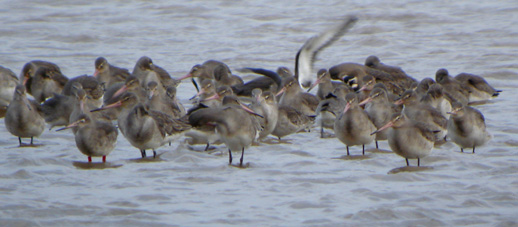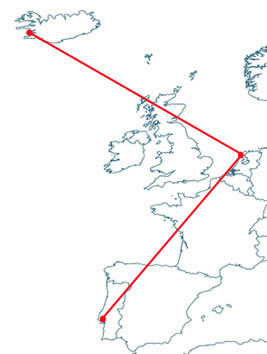
|
Recent findings in Icelandic Godwit research What is the Icelandic Godwit population size? This question was tackled using Capture-Mark-Recapture analyses of sightings of godwits on arrival in Iceland. These calculations suggested that, when the analyses were completed in 2003, there were approximately 37,500 adult Icelandic Black-tailed Godwits breeding in Iceland. Assuming that each pair produces 0.5 chicks which reach the wintering grounds gave a winter population estimate of around 47,000 individuals. This research is published in: Gunnarsson, T.G., Potts, P.M., Gill, J.A., Croger, R. E., Gelinaud, G., Atkinsson, P.W. Gardarsson, A. & Sutherland, W.J. 2005. Estimating population size in Icelandic Black-tailed Godwits Limosa limosa islandica by colour-marking. Bird Study 52: 153-158.
Do Icelandic godwits wintering on more favourable sites arrive earlier on the breeding grounds? Detailed studies of the foraging behaviour of Icelandic Black-tailed Godwits on estuaries in east (Suffolk and Essex) and south (Solent) England allowed us to show that, by the end of the winter, conditions on the southern estuaries are much better than on the eastern estuaries, because the birds deplete virtually all of the intertidal invertebrates on the eastern estuaries. In the south, access to grasslands adjacent to some of the estuaries means that the birds have an alternative food supply. These differences in food supply may be why birds from eastern England have significantly lower survival rates than those from the south. Our studies in Iceland showed that birds from the south coast sites arrived in Iceland earlier than those from the east, suggesting that winter conditions can have important consequences for the breeding season as well as for survival. This research is published in: Gill, J.A., Norris, K., Potts, P.M., Gunnarsson, T.G., Atkinson, P.W. & Sutherland, W. J., 2001. The buffer effect and large-scale population regulation in migratory birds. Nature 412: 436-438. Are breeding and winter site quality linked? In Iceland, Godwits breed primarily on coastal marshes and inland dwarf-birch bogs. The average breeding success varies between these two habitats, with more chicks per pair fledging on marshes, possibly because the invertebrate food supplies are more abundant and more accessible on marshes. Intriguingly, of the colour-marked godwits from these breeding areas that winter in England, those from marsh habitats are more likely to winter in the better quality south coast sites, whereas birds from dwarf-birch bogs are more likely to winter on the poorer quality east coast sites. Thus, individuals tend to have either high survival and breeding success, or low survival and breeding success. These links have very important implications for how the population is likely to fare in the future, which we are continuing to explore. This research is published in: Gunnarsson, T.G., Gill, J.A., Newton, J., Potts, P.M. & Sutherland, W.J. 2005. Seasonal matching of habitat quality and fitness in a migratory bird. Proceedings of the Royal Society of London B 272: 2319-2323. Do Icelandic Godwit pairs stay together throughout the year? Icelandic Black-tailed Godwits arrive in Iceland over a month long period from mid April to mid May. However, pairs of Godwits arrive on their territories within an astonishing 2-3 days of one another. How is this level of synchrony achieved? The obvious solution is that pairs stay together in winter and summer. However, tracking of colour-ringed pairs has shown that this is certainly not the case – in fact males and females of a pair winter, on average, around 1,000 km apart. The tracking of these birds has also shown that they do not meet on migration. So how do they do it? We don’t yet know the answer to this question, but we keep working on it! This research is published in: Gunnarsson, T.G., Gill, J.A., Sigurbjörnsson, Þ. & Sutherland, W.J. 2004. Arrival synchrony in migratory birds. Nature 431: 646. What routes do Icelandic Godwits take between and within countries? Tracking marked bird’s movements allow to outline the importance of a given site for the conservation of the species. Movements on a larger scale are easier to access, once the movement within countries would imply an even more fine scale network of observers. However, the movements of marked birds on a larger scale already show interesting patterns during migration. We know that individuals wintering on the northernmost part of the range, England, Ireland and the Netherlands, migrate directly to Iceland. But individuals wintering on the south of the range, Portugal, Spain and France move north, mainly to the Netherlands, before departing to Iceland. We currently don´t know why this happens but work is under way in order to better understand these different strategies and the trade-offs involved.
|

Have you seen one of these?
Let us know about it!
